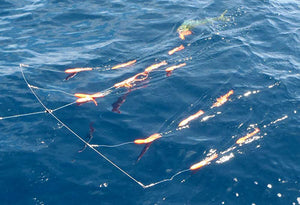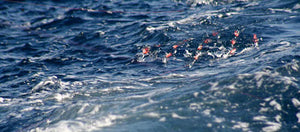Spreader bars
$115.00
| /
Product information:
- Trolling/Lure teaser
- 15 squids mounted to replicate a surface school with the last squid carrying a heavy duty gamefish hook
- 106cm bar made from Monel wire
- Weight: 200 grams
- Packaging: 110 x 26cm bag with clear PVC front, mesh back for quick drying and Velcro closure
- Delivery included in Australia
I'll never forget the first time we got onto them.
Maybe twenty five years ago – before the internet, anyway – I ordered a couple by mail through the (totally awesome) Edge fishing magazine.

Due to a mix up they were sent by sea mail so, took ages to get here. But when they arrived we were so excited we went out the next day on Graeme Almond’s Bertram 25 and hooked up a striped marlin within 30 minutes of deploying one.
For some reason – probably, because Graeme sold his boat soon after –
I stopped using them, and they sat in the back of the garage for twenty years.
Anyway, some bright spark came up with the idea that they might be good for kingfish at Long Reef. We’re all familiar with the spectacle of small pods of bait fish like sauris or gar moving fast and nervously through the danger zone, to escape predators.
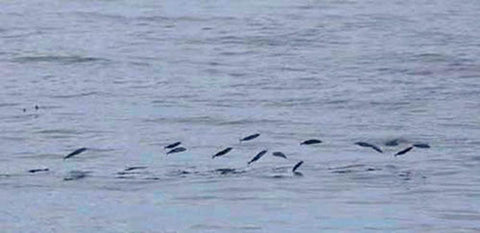
Predators hit them hard:

Here’s an amazing video showing spreader bars in operation. Giant Atlantic bluefin tuna slamming hookless plastic squid, definitely worth a look:
You see sauris showering out of the water between the 80-fathom line and Browns, all winter. Stand on the Crowdy Head breakwall or the rocks at Charlotte Head in February or March and watch the longtail tuna send small schools of garfish leaping, to escape attack. The idea was, replicate that, but put a separate bait or lure behind the spreader bar to imitate the weak tail end charlie, trailing the school. We made a half hearted attempt at this project last year, using a welded stainless bar set up I bought from Mo Tackle. That one didn’t work because the heavy bar makes too much splash and drag and distracts from the lures, which should be the focus.
So when our biggest tackle supplier brought out his new catalogue recently, and I saw he had the light, springy Monel-type wire bars newly added to the range, I was interested. So interested that I ordered ten, on spec. They arrived in late January 2014, just in time for the peak of the kingfish run at Long Reef.
Here’s specifications:
Model: Spreader Bar
Description: Trolling lure/Teaser
Specifications: 15 squids mounted to represent a surface school, with the last squid carrying a heavy duty game fish hook. 106cm bar is made from special Monel wire. Tail end squid (with hook) can be supplied with crimped loop, so it can be quickly removed when the spreader bar is required to be a teaser only.
Weight: 200 grams
Price: $95
Packaging: 110 x 26cm bag with clear PVC front, mesh back for quick drying, and Velcro closure
Obviously, I didn’t want to fish them the way they are normally fished. Because the thought that a hooked kingfish dragging around a spreader bar and fourteen squids was somewhat unsporting. So we removed the stinger lure (with the hook fitted) from the spreader bar.

Then we attached the bar to the downrigger clip, in place of the heavy lead weight usually fitted. The boat sped up to around 3.5 – 4 knots, and the spreader bar run out on the downrigger cable maybe 15 – 20 metres behind.
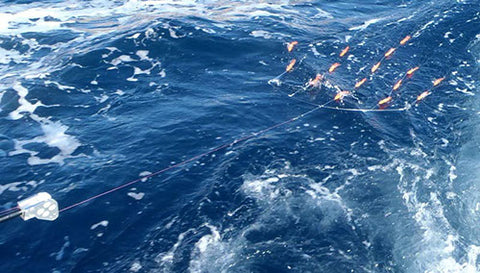
The rod was dropped into the downrigger rod holder and the popper was set about three metres behind the spreader bar. The effect was that of a nervous school of large baitfish skittering along the surface, and just behind the school a wounded bait fish in trouble and struggling, to keep up.

The results were incredible. Kingfish hit multiple squids in the array, very spectacular. And of course, the poppers. We were using Halco Roostas, painted black with a Texta for maximum contrast. Kingfish not big that day but strikes super visual, I was having a ball:
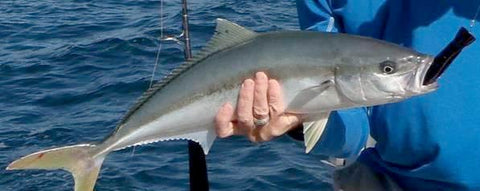
At times it was like those videos you see where giant trevally hit a popper repeatedly as it’s retrieved towards the boat – although on a much smaller scale, of course.
Here's how it looks:
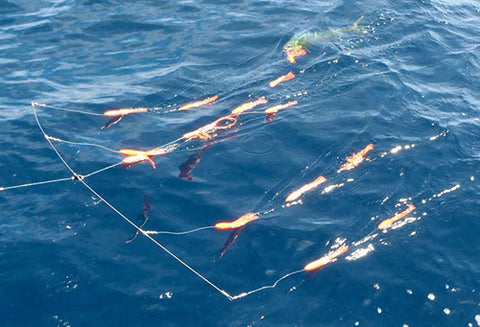
This technique, which I call ‘uprigging’, has some big benefits. Firstly, you’re working the water surface. Meaning you can get the boat up in the shallows, close to the rocks, which is often where the big fish are. Secondly, everything’s on the surface and up nice and close. That’s a plus because, with big kingfish, the last thing you want to do is give them extra line or present a bait close to the bottom. That just makes it easy for them to reef you. With this method the kingfish – or mackerel, longtail tuna, coral trout or whatever – has to do the climbing. Not your bait or lure, doing the diving. So we ordered a large shipment of the best performing spreader bar, a large one with 15 red six inch squids:
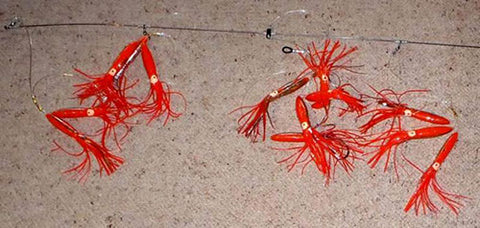
The bar is 102cm long and there are five sets of squids in this order: 2-3-5-3-2.
These can be somewhat hard to manage and store onboard so we ordered a mesh backed Velcro sealed bag, for each one:

We haven’t had these long but they’re working well already. Ian Beavis:

"Andrew, just a short note to say we had a great time last Saturday with the teaser I purchased from you last week. We were trolling the teaser with dollys chasing the teaser and a marlin chasing the dollys we sent a lure out past the teaser and caught our first marlin out of Broken bay See attached picture of the 35 kg Marlin"
PLEASE – someone give them a try on southern bluefin? They should work just as well on those as they do on the giant Atlantic bluefin shown in the video above. Send me an email if more information is needed?
Thanks for reading, Andy
You may also like
Sign up to get the latest fishing reports, how to's and tackle news
© 2024 Downriggershop.
Powered by Shopify




